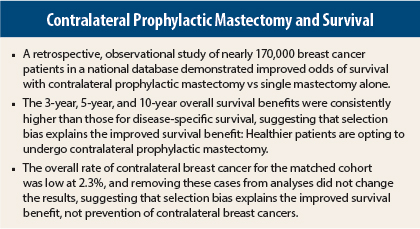Contralateral prophylactic mastectomy improved breast cancer patients’ odds of overall survival by 23% compared with single mastectomy alone, according to a retrospective analysis of nearly 170,000 patients in a U.S. database, but surgical breast cancer specialists warned that the data needed to be interpreted cautiously.
Patients with unilateral, nonmetastatic breast cancer who underwent contralateral prophylactic mastectomy had a lower risk of death (hazard ratio [HR] = 0.77, 95% confidence interval [CI] = 0.73–0.82) relative to patients who had single mastectomy alone, reported Rondi Kauffmann, MD, of City of Hope in Duarte, California, at the 2014 Society of Surgical Oncology (SSO) Cancer Symposium in Phoenix.1
In addition, the authors reported that the hazard ratio for disease-free survival with contralateral prophylactic mastectomy was 0.85 (95% CI = 0.79–0.92) compared to patients who had single mastectomy alone.
Study Details
Dr. Kauffmann and colleagues conducted a retrospective, observational study of patients identified from the Surveillance, Epidemiology, and End Results database. All subjects had newly diagnosed breast cancer and underwent mastectomy with or without contralateral prophylactic mastectomy, from 1998 to 2010. She explained that the contralateral prophylactic mastectomy rate increased from 4% at the beginning of the study in 1998 to 22% in 2010. Her group looked at survival differences for the whole study population and for those aged 50 and up.
The total cohort consisted of 169,631 patients; 141,616 had single mastectomy alone, whereas 28,015 underwent contralateral prophylactic mastectomy. The authors performed a matched, case-control analysis with patients matched based on several factors including age, race, grade, estrogen-receptor status, and nodal status, Dr. Kauffmann explained.
In terms of patient demographics, the authors reported a statistically significant difference for some patient and tumor characteristics, but the absolute differences were small, Dr. Kauffmann pointed out. For example, 81.9% of women who underwent single mastectomy alone were white vs 82.6% in the contralateral prophylactic mastectomy group (P = .0772). Also, 64.7% of women in the single mastectomy–only arm had node-negative status vs 65.5% in the contralateral prophylactic mastectomy arm (P = .0640).
“This led us to conclude that this statistically significant P value was a function of our extremely large sample size of 28,000 patients in a matched cohort, and that the differences between the two groups were so small as to not be clinically relevant. We concluded that these groups were well matched,” Dr. Kauffmann said.
The group reported that increased age, larger T classification, African American race, poorly differentiated grade, positive nodal status, and receptor-negative status were associated with an increased risk of breast cancer–specific death.
Survival Data
The 3-, 5-, and 10-year overall and disease-specific survival rates were determined for patients who had contralateral prophylactic mastectomy and single mastectomy. The overall and disease-specific survival rates were higher for contralateral prophylactic mastectomy patients than for single mastectomy patients for each of the follow-up time periods, yet consistently overall survival rates were greater than disease-specific rates.
The authors then looked to see if the survival advantage persisted when excluding younger patients in whom the high-risk BRCA mutation was overrepresented. They still found a survival benefit for contralateral prophylactic mastectomy vs single mastectomy.
Dr. Kauffmann highlighted the limitations of this retrospective research including a lack of data on the use of therapy other than surgery. Also, information on comorbidities and BRCA status could not be obtained. Finally, “despite the use of propensity score to match patients and distribute co-
morbities between the two cohorts, it is likely that some residual confounding remains,” she said.
Nevertheless, these data do “contribute to the existing body of literature on contralateral prophylactic mastectomy,” she said.
‘Potentially Harmful’
One attendee at the SSO meeting took issue with the interpretation of the differences between the two groups, especially given the large sample size.
“I think you have to be really careful with the issues of causality and association with a retrospective study with very high statistical power,” warned Kimberly Van Zee, MD, of Memorial Sloan Kettering Cancer Center in New York. “You discounted the statistical significance of the imbalance between your two groups even after propensity matching. All the imbalance was in the direction of the contralateral prophylactic mastectomy group having lower risk.”
Dr. Van Zee also pointed out that “the overall survival benefit is greater than the disease-free survival benefit, proving that your contralateral prophylactic mastectomy group was at lower risk of dying and were selected to be lower-risk patients.”
Dr. Van Zee said the study’s conclusion that contralateral prophylactic mastectomy conferred a survival advantage was “potentially harmful and [a form of] misinformation if it’s based on inappropriate conclusions [from the data]…”
Dr. Kauffmann conceded that that “the effect of the confounders is clearly impacting the overall survival much more heavily than the disease-free survival. Certainly, this is a difficult topic because we’ll never have a randomized controlled trial. Unfortunately, short of a multicenter study where we can control for comorbidities, chemotherapy, and other types of treatment other than just surgery, it is fraught with potential danger for interpreting overstrongly.”
Real-World Implications
Monica Morrow, MD, of Memorial Sloan Kettering Cancer Center, also drew attention to the hazard of overinterpreting the results.
“I think the reason that we are all concerned about this is that, while you clearly understand the limitations of the dataset, what gets out there in the world is simply, ‘[Contralateral Prophylactic Mastectomy] Improves Survival,’” she said. “So to ask the question in a slightly different way, … What was the incidence of contralateral breast cancer in the unilateral arm?”
In response to Dr. Kauffmann’s reply that the incidence was low at 3% to 5%, Dr. Morrow pointed out “you are showing 3% to 5% survival differences, which implies that every single patient who got contralateral breast cancer died of her disease in this followed-and-screened cohort, which we know is extremely unlikely. I would just join [Dr. Van Zee] in saying that I would be exceedingly careful in overinterpreting the data.”
With these cautionary words by Drs. Morrow and Van Zee, senior investigator Laura L. Kruper, MD, of City of Hope, returned to the data to perform additional analyses. “One of the benefits of being able to present one’s data at a large scientific meeting is that it allows a study’s results to be scrutinized before publication. We greatly appreciate the comments from both Drs. Morrow and Van Zee since they are leaders in breast cancer research and understand the complexities of population-based studies,” she told The ASCO Post.
Further Analyses
With the additional analyses, the cases of contralateral breast cancer in the cohort were further investigated. Within the matched cohort of contralateral prophylactic mastectomy and single mastectomy patients, 2.3% of the patients developed a contralateral breast cancer, which is low. First, a multivariate analysis was performed with the original variables of the study now including contralateral breast cancer as a variable. The hazard ratio for the overall survival rate with contralateral prophylactic mastectomy was 0.77 (95% CI = 0.73–0.82). When all cases of contralateral breast cancer were removed from the analysis, the hazard ratio did not change (HR = 0.77, 95% CI = 0.72–0.82). This led the authors to conclude that the improvement in survival was not from prevention of contralateral breast cancer.
“The people who would most benefit from [contralateral prophylactic mastectomy] are those who are at high risk of developing a contralateral breast cancer. However, by prevention of [contralateral breast cancer], we would expect the disease-specific survival benefit to be greater than overall survival benefit, and this is not what we are seeing,” Dr. Kruper said.
“In our additional analyses, we demonstrated that the low rate of [contralateral breast cancer] in the cohort has little impact on the survival rates, implying that the increased survival seen with [contralateral prophylactic mastectomy] is from selection bias: Those who are healthier or lead healthier lifestyles are either choosing [contralateral prophylactic mastectomy] or are chosen to undergo [contralateral prophylactic mastectomy]. This selection bias also potentially explains why the overall survival benefit was consistently greater than the disease-specific survival benefit in our study,” she concluded.
Recurrence Rates
In response to another attendee’s question regarding recurrence rates, the stage at which patients presented with recurrence, and adherence to a screening schedule, Dr. Kauffmann said her group is currently analyzing the dataset for that information. Regarding those analyses, Kruper et al were subsequently able to demonstrate that the development of a contralateral breast cancer had varying effects on survival.
For those who presented with a “low stage” contralateral breast cancer (in situ to stage II), there was an improved survival benefit whereas those presenting with a “high stage” contralateral breast cancer (stage II to IV) had an increased risk of death. According to Dr. Kruper, this also demonstrates selection bias with those undergoing routine surveillance, having contralateral breast cancers detected at an earlier stage. “The improved survival is not from the [contralateral breast cancer] but from the regular health maintenance.” ■
Disclosure: Drs. Kauffmann, Morrow, Kruper, and Van Zee reported no potential conflicts of interest.
Reference
1. Kauffmann R, Nelson R, Smith D, et al: Improved survival with contralateral prophylactic mastectomy. 2014 Society of Surgical Oncology Cancer Symposium. Abstract 12. Presented March 15, 2014.







